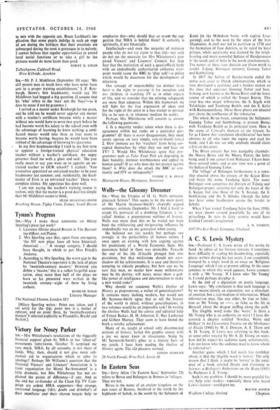A C. S. Lewis Mystery SIR,—Professor C. S. Lewis wrote
all his works by hand. As editor of his literary remains, I sometimes have difficulty in reading his handwriting, especially pieces written during his last years. I am completely stumped by a single word in an essay on 'Religious Language' which I am at present editing. In the same sentence in which this word appears, Lewis connects it with a `Mr Young.' If I knew who 'Mr Young' is, I could perhaps decipher it.
At the end of a digression on poetic language, Lewis says: 'My conclusion is that such language is by no means merely an expression, nor a stimulant, of emotion, but a real medium of information. Which information may, like any other, be true or false: true as Mr Young on —, or false as the bit in Beowulf about the dragon sniffing along the path.'
The illegible word looks like 'weirs.' Is there a
Mr Young who is an authority on weirs? I have dis- covered a chapter entitled 'Notches, Weirs and Orifices' in An Elementary Treatise on the Mechanics of Fluids (1960) by W. J. Duncan, A. S. Thom and A. D. Young. If Lewis was referring to this book, or some other treatise by Mr A. D. Young on weirs. how did he expect his audience (and, unfortunately, I do not know who the audience was) to know whom 11a referred to?
Another guess which I feel much less confident
about, is that the illegible word is 'nerves.' The only reason that I think it might be 'nerves' is the exist- ence of a book entitled Doubt and Certainty in Science: a Biologist's Reflections on the Brain (1951) by Professor J. Z. Young.
Such is my problem. I should be most grateful for any help your readers—especially those who heard Lewis's lecture—could give me.
WALTER HOOPER






































 Previous page
Previous page